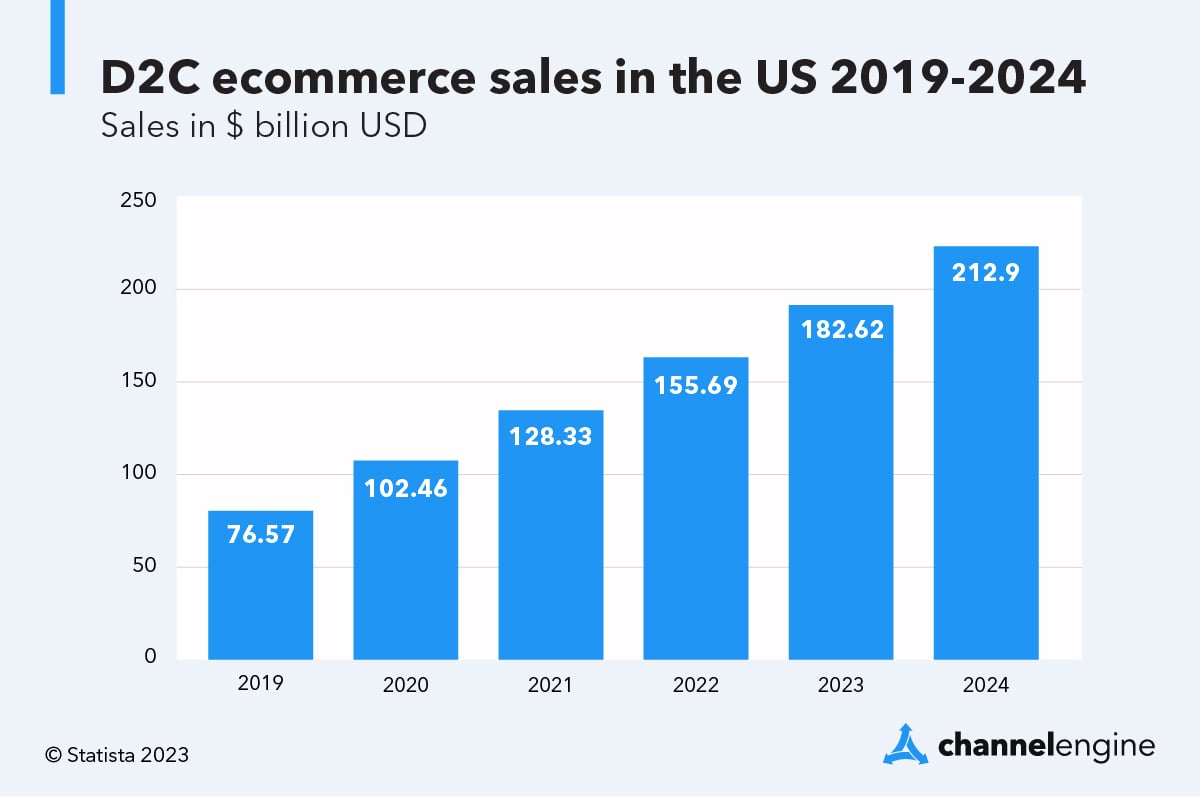Checking out the Prospective of D2C Ecommerce: A Comprehensive Guide for Services
The D2C ecommerce model provides a substantial shift in exactly how brands engage with customers. It enables business to bypass typical retail networks, cultivating deeper connections and potentially raised earnings margins. Nonetheless, this approach is not without its complexities. Recognizing the nuances of D2C ecommerce is vital for brand names intending to prosper. What strategies can they take on to navigate this progressing landscape effectively? The responses might redefine their organization strategies.
Recognizing the D2C Ecommerce Version

Key Benefits of D2C Ecommerce for Brands
The D2C ecommerce version offers brands considerable benefits, particularly pertaining to increased earnings margins. By eliminating intermediaries, companies can preserve a larger share of sales revenue. In addition, this straight relationship with customers promotes boosted brand name commitment, encouraging repeat purchases and lasting interaction.
Increased Revenue Margins

Improved Brand Loyalty
Building on the economic advantages of D2C ecommerce, improved brand name loyalty emerges as an additional vital advantage for firms involving directly with consumers. By developing a straight link, brand names can promote much deeper connections with their customers, acquiring understandings into behaviors and choices. This straight interaction allows for even more personalized marketing strategies, which resonate strongly with customers. In addition, brand names have the possibility to regulate their messaging and consumer experience, strengthening brand values and constructing trust fund. When clients feel an individual link, they are most likely to return, promote for the brand, and take part in neighborhood involvement. Inevitably, improved brand loyalty not just drives repeat acquisitions however additionally grows an enthusiastic client base, more strengthening a brand name's placement on the market.
Difficulties Dealt With by D2C Brands
D2C brands come across a number of significant difficulties that can impact their success. Stock management problems can result in stock shortages or excess, complicating procedures and client contentment. Furthermore, advertising and marketing budget plan constraints commonly limit the capability to effectively engage and reach target audiences.
Inventory Administration Issues
Reliable inventory management offers a powerful difficulty for lots of brand names running in the direct-to-consumer (D2C) room. These brands often come to grips with changing need, which can cause overstock or stockouts, eventually influencing client fulfillment and revenue. In addition, the absence of innovative inventory radar can cause inconsistencies between real supply levels and reported data, making complex order gratification. The varied series of products D2C brand names commonly offer likewise makes complex inventory administration, as variations in styles, dimensions, and shades call for even more thorough oversight. Moreover, several D2C businesses may have problem with minimal warehousing capacities, leading to inefficient use room and resources. Efficient inventory management continues to be an important difficulty for D2C brands aiming for lasting development and operational efficiency.
Marketing Budget Plan Constraints
Maneuvering marketing budget restraints is a significant challenge for many direct-to-consumer (D2C) brands. Minimal funds typically restrict these companies' capacity to purchase all-encompassing advertising and marketing methods, resulting in minimized presence in an open market. D2C brand names regularly come to grips with the demand to make the most of roi (ROI) while targeting details audiences properly. This obstacle is intensified by rising prices in digital advertising and marketing and the requirement to assign funds throughout numerous channels, consisting of social media, online search engine, and e-mail marketing. Consequently, lots of D2C brands have to innovate cost-efficient advertising and marketing services, leveraging organic Read Full Report growth methods and influencer collaborations. Ultimately, efficiently steering these spending plan restraints is necessary for sustaining growth and achieving lasting success in the developing ecommerce landscape.
Methods for Constructing an Effective D2C Ecommerce Organization
As consumers increasingly look for direct links with brands, establishing an effective D2C ecommerce company requires a critical technique that focuses on client involvement and trust fund. One efficient strategy is to develop compelling brand name stories that resonate with target market, fostering psychological connections. Using social media platforms can boost presence and help with two-way interaction, enabling brand names to involve directly with customers.Moreover, individualized experiences through customized marketing efforts can substantially improve customer retention and loyalty. Carrying out loyalty programs and providing special bargains can further incentivize repeat purchases.Streamlining the buying process is vital, making sure a straightforward interface that enhances the purchasing experience. Furthermore, transparent communication pertaining to shipping and returns develops depend on and motivates consumer confidence.Finally, proactively looking for client responses and replying to it shows a dedication to enhancement and consumer satisfaction, important elements in the competitive D2C landscape.
Leveraging Innovation for Boosted Client Experience
In today's affordable D2C ecommerce landscape, modern technology plays a critical role fit client experiences. Companies significantly make use of sophisticated tools such as artificial knowledge, chatbots, and personalized algorithms to improve interactions and enhance the buying procedure. By integrating these innovations, brands can supply tailored product suggestions based upon private choices and shopping behaviors, cultivating a more appealing experience.Moreover, responsive web site styles and mobile applications assure that consumers can access solutions effortlessly throughout various tools. Boosted payment solutions, consisting of digital budgets and one-click check outs, even more simplify purchases, making it easier for consumers to make purchases.Data analytics additionally allows companies to gather insights into consumer habits, enabling continuous enhancement of offerings and services. Overall, leveraging technology not only enhances customer contentment however likewise grows loyalty, ultimately driving long-lasting success in the D2C ecommerce field.
Advertising Techniques to Drive D2C Sales
How can brand names effectively capture the attention of consumers in a saturated market? To prosper in the direct-to-consumer (D2C) landscape, brands should employ targeted marketing tactics. Using social media sites systems, brands can engage consumers via interactive content, influencer partnerships, and user-generated blog posts. Personalized e-mail projects can also foster a feeling of link, offering tailored promos based on customer actions and preferences.Moreover, storytelling plays a vital duty in differentiating a brand's story, making it remarkable Visit Your URL and relatable. Brand names need to buy search browse this site engine optimization (SEO) to enhance exposure, ensuring their products are quickly discoverable online. In addition, leveraging data analytics allows businesses to improve their advertising methods and comprehend consumer patterns better. Eventually, a multi-channel strategy that incorporates creative thinking with data-driven insights can considerably enhance D2C sales, permitting brands to stand out in a congested industry.
Future Fads in D2C Ecommerce
With the quick advancement of modern technology and customer preferences, the future of D2C ecommerce is poised for substantial makeover. Arising patterns suggest a change towards hyper-personalization, where brand names utilize data analytics to tailor offerings to specific consumer requirements. This personalization improves customer experiences, promoting loyalty and engagement.Moreover, sustainability is ending up being an essential element, with consumers increasingly favoring brands that prioritize environment-friendly techniques - D2C Ecommerce Agency. Business are expected to take on transparent supply chains and sustainable materials to meet this demand.The assimilation of synthetic intelligence and increased reality will in addition revolutionize the buying experience, permitting customers to visualize items in their atmospheres before purchase. Additionally, social business is prepared for to expand, as platforms like Instagram and TikTok facilitate seamless buying experiences straight within social media.These trends jointly represent a vibrant future for D2C ecommerce, stressing customer-centric techniques and innovative technologies that redefine consumer communications
Regularly Asked Inquiries
What Industries Benefit The Majority Of From D2C Ecommerce?
The present question highlights markets that grow with direct-to-consumer (D2C) ecommerce. Incredibly, style, beauty, electronic devices, and food industries take advantage of D2C models to boost brand name commitment, enhance customer connections, and optimize profit margins properly.
How Do Shipping Expenses Impact D2C Prices Methods?
Delivering prices substantially influence D2C pricing strategies. Businesses need to balance these expenditures with competitive prices, taking into consideration client expectations and profit margins. Reliable management of shipping can improve customer contentment and drive sales in direct-to-consumer designs.
What Payment Alternatives Should D2C Organizations Deal?
D2C businesses should use varied settlement options, consisting of credit/debit cards, digital pocketbooks, and buy currently, pay later services. This range enhances consumer comfort, boosts conversion rates, and satisfies various customer preferences in the online buying landscape.
How Can D2C Brands Take Care Of Client Returns Properly?
D2C brands can handle customer returns efficiently by executing straightforward return plans, supplying prepaid delivery tags, and ensuring punctual reimbursements (D2C Ecommerce Agency). Clear interaction and structured processes boost client contentment and urge repeat business
What Legal Factors To Consider Exist for D2C Ecommerce Operations?
Lawful factors to consider for D2C ecommerce procedures consist of conformity with consumer security legislations, information privacy guidelines, copyright civil liberties, and tax needs. Brand names need to browse these intricacies to avoid lawful risks and ensure smooth procedures. By removing middlemans, D2C brands can use affordable rates and foster a much more intimate relationship with their customers.The D2C model is defined by its dependence on digital systems, making it possible for brand names to use social media, on the internet marketplaces, and their very own websites to involve with consumers directly. D2C ecommerce assists in the collection of important consumer information, making it possible for brands to tailor their offerings and advertising approaches efficiently, inevitably driving sales and raising margins. Furthermore, brands have the chance to manage their messaging and customer experience, reinforcing brand worths and developing trust. As consumers significantly seek straight links with brands, establishing a successful D2C ecommerce organization requires a calculated approach that prioritizes customer engagement and count on. D2C brands can take care of customer returns properly by executing straightforward return plans, using pre paid shipping tags, and guaranteeing punctual reimbursements.